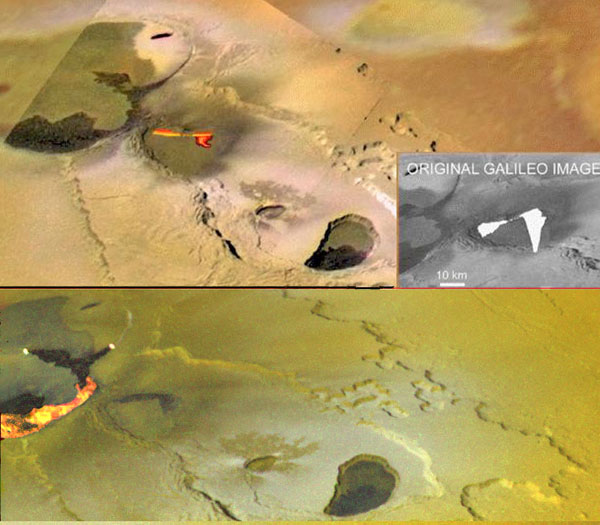|

from
HoloScience Website
Dec 17,
2004

Credit:
NASA/JPL
Don’t be misled by the
sheets of “flame” depicted in the above images of the
Tvashtar region of Io, Jupiter’s closest
Moon. Planetary scientists have colored in bleached-out areas on
the photographs taken by the Galileo probe, converting
the images into what they had expected to find — lava fountains.
The Galileo spacecraft caught the “volcanic eruption”
of the top photograph on November 25, 1999, and the NASA
release explains:
“The molten lava was
hot enough, and therefore bright enough, to saturate, or
overexpose, Galileo’s camera.”
The original image is
inset in the lower right corner of the photograph. According to the
release,
“surface flows shown
in the color image were assembled as an interpretive drawing by
Galileo scientists”.
Yet no lava flow
ever witnessed has exhibited temperatures so high as to produce the
effect seen in the original Galileo image.
The lower photograph, taken on February 22, 2000, shows a
super-heated region that is more than 60 kilometers (37 miles) long.
NASA released the picture in false color,
leaving the unfounded impression that the picture is showing a
conventional lava fountain.
“The lava
appears to be producing fountains to heights of up to 1.5
kilometers (5,000 feet) above the surface”.
This image is actually a
processed mosaic combining images taken in the near-infrared,
clear, and violet filters. All that later analysis could determine
is that temperatures exceeded 1200 K. To place the matter in
perspective, with attention to the alternative electrical
explanation: a lightning discharge "pinches" down to a
few centimeters diameter (or possibly meters in the case of the
diffuse discharge on Io) where it meets a conducting
electrode. So if the instruments were detecting an electric
discharge any temperature reading, averaged over a much
larger region than the actual heat source, would have greatly
understated the real temperature.
Nevertheless, the radiation was so intense that it overloaded the
Galileo camera, as if it were looking at a line of arc lights,
producing "whiteouts" on the electronic images.
The electric interpretation suggests that continuous
electrical arcing has etched the surface of Io, creating flat plains
and bluffs with scalloped edges. In much the same way, electric arcs
are used in industry to machine metallic surfaces to a high level of
precision. The most recent etching in this region has exposed the
dark surface below the falling sulfur dioxide snow, and in the lower
picture we see two bright spots where it appears that arcs are
continuing to extend the excavated area in two directions.
|
